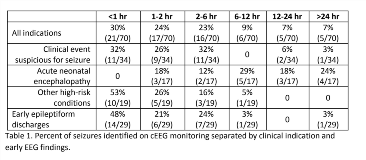The Probability of Seizures During EEG Monitoring in High-Risk Neonates
Abstract number :
2.012
Submission category :
3. Neurophysiology / 3A. Video EEG Epilepsy-Monitoring
Year :
2018
Submission ID :
501494
Source :
www.aesnet.org
Presentation date :
12/2/2018 4:04:48 PM
Published date :
Nov 5, 2018, 18:00 PM
Authors :
Lila Worden, Massachusetts General Hospital; Jacquelyn Gold, Massachusetts General Hospital; Dhinakaran Chinappen, Massachusetts General Hospital; Mark Kramer, Boston University; M. Brandon Westover, MGH/Harvard; and Catherine J. Chu, Massachusetts Genera
Rationale: Continuous EEG monitoring (cEEG) of high-risk neonates has been recommended due to the high incidence of seizure in this population; however, optimal duration of monitoring and frequency of review remain uncertain for this limited resource. We characterized seizure risk over time in relation to monitoring indication and early EEG features in a large population of neonates monitored following American Clinical Neurophysiology Society (ACNS) criteria. Methods: All neonates 34-48 weeks postmenstrual age monitored at Massachusetts General Hospital from May 2009 – October 2017 were included (preliminary n= 282). Charts were reviewed for monitoring indication per ACNS guidelines (clinical event suspicious for seizure, acute neonatal encephalopathy, or other high-risk condition), and use of anti-seizure medication (ASM) before monitoring. EEG reports were monitored for early (first 30-60 minutes of recording) interictal epileptiform discharges (“early IEDs”) and presence of seizure. We examined the association between features of interest and seizure probability via logistic regression model. Results: Preliminary results show that seizures occurred in 26% (70/282) of neonates during cEEG monitoring (19% if acute neonatal encephalopathy, 24% if clinical event suspicious for seizure, 34% if other high-risk condition). Among those with seizures, the first seizure occurred in <1 hour in 30%, 1-2 hr in 24%, 2-6 hr in 23%, 6-12 hr in 9%, 12-24 hr in 7%, and >24hr in 7% (Figure 1A, Table 1). Of five patients who had their first detected seizure after 24 hr, four were undergoing therapeutic hypothermia for acute neonatal encephalopathy. Seizures were detected in 52% of patients with early IEDs versus 18% of those without.In the best-fit multiple regression model, duration of cEEG monitoring, presence of early IEDs, and indication for monitoring were each significant. The odds of seizure decreased over time such that there was a 10% reduction in the odds of seizure with each 1 hour of monitoring (p<0.001, OR 0.9 95%CI [0.87, 0.93]). There was an increase in the odds of seizure if early IEDs were present (p<0.001, OR 3.74 [2.2, 6.3], Figure 1B). There was a decreased risk of seizure for neonates monitored due to a clinical event suspicious for seizure (p=0.037, OR 0.54 [0.30, 0.98]) or acute neonatal encephalopathy (p=0.028, OR 0.47 [0.23, 0.93]) compared to other high-risk conditions (Figure 1C). The administration of ASM before monitoring did not predict seizure risk. Conclusions: Neonates are at high risk of seizure, especially within the first 6 hrs of cEEG monitoring, and higher in those monitored for high risk conditions outside of acute neonatal encephalopathy or for suspicious clinical events. Most seizures will not occur in the first hour of recording, however monitoring indication and the presence of early epileptiform discharges may identify those patients at increased risk of developing seizure and who should be considered for more frequent cEEG review. Funding: Dr. Chu receives funding from NIH K23 NS092923. Dr. Westover receives funding from NIH-NINDS 1K23NS090900, 1R01NS102190-01.
